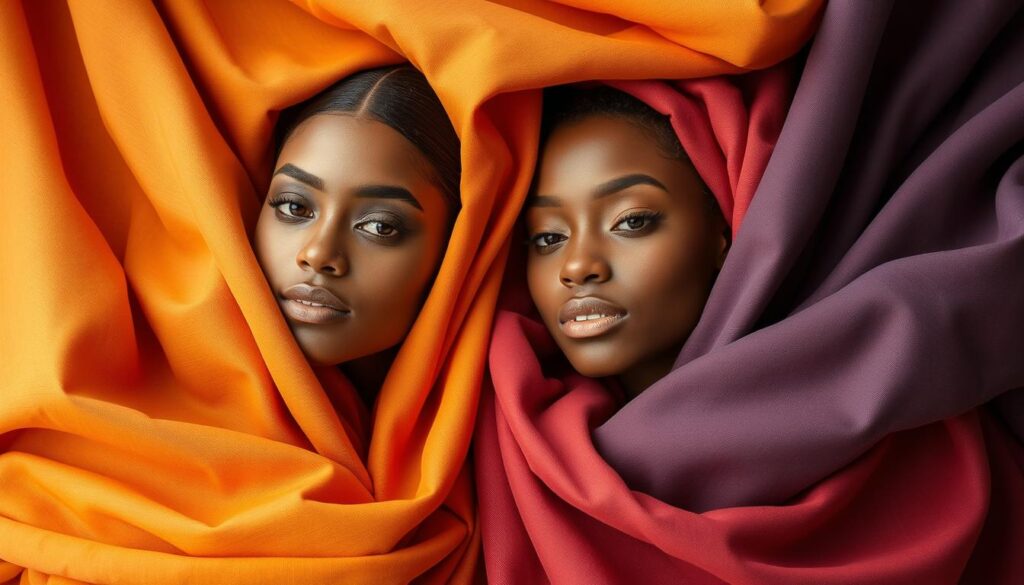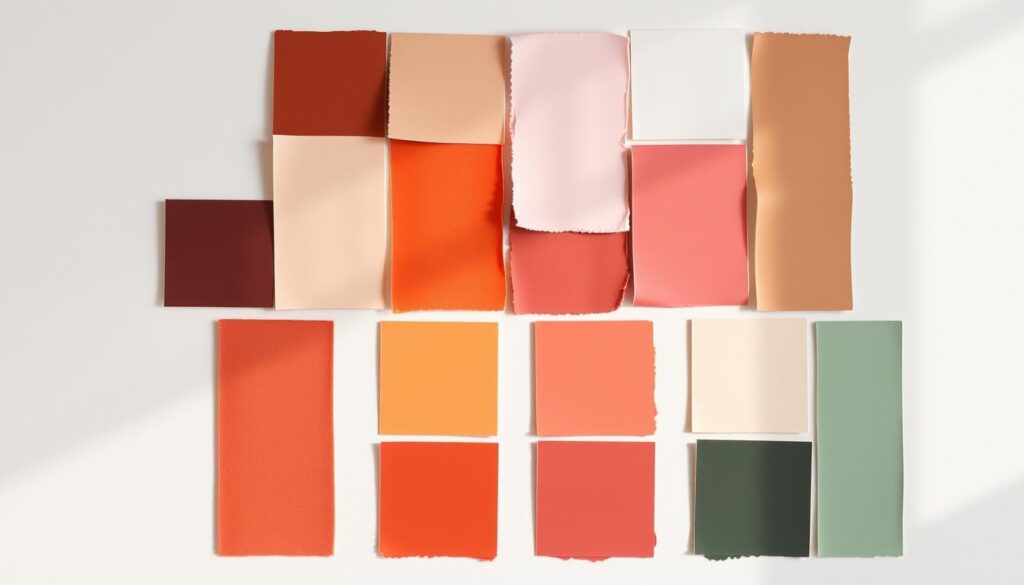Discovering the best colors for your skin tone can change how you look and feel. Millions of people are interested in color analysis, as seen on TikTok. The book “Color Me Beautiful” by Carole Jackson has sold over 13 million copies worldwide.
Understanding your skin tone and undertones helps you choose the right colors. This can make you look polished and confident. The right colors can highlight your natural beauty and make you stand out.
This article will help you find the best colors for your skin tone. We’ll cover understanding skin tone, undertones, and finding flattering colors. You’ll learn how to unlock your personal style and confidence.
Introduction to Color Analysis
Color analysis helps you find the most flattering colors for your skin tone and style. It considers your individual characteristics. This way, you can create a color palette that enhances your natural beauty.
Key Takeaways
- Understanding your skin tone and undertones is key to finding the most flattering colors.
- The right colors can enhance your natural beauty and make you look more vibrant and confident.
- Color analysis is a personalized approach to finding the best colors for your skin tone, hair color, and personal style.
- Millions of people are interested in color analysis, with over 13 million copies of “Color Me Beautiful” sold worldwide.
- Finding the best colors to wear for your skintone can seem overwhelming, but with the right guidance, you can learn to choose the most flattering colors.
- Flattering clothing colors can make a significant difference in your overall style and confidence.
Understanding Skin Tone and Undertones
Finding the right skin tone fashion colors starts with knowing your undertones. Your skin tone is the main color of your skin. Undertones are the subtle colors beneath the surface. To find out your undertones, look at the veins on your wrist’s inside. Blue or purple veins mean cool undertones. Green veins indicate warm undertones. Neutral undertones are hard to tell.
Knowing your undertones helps pick the ideal shades for your complexion. Warm undertones look great in earthy tones like mustard and olive. Cool undertones shine in jewel tones like sapphire and emerald. Neutral undertones can wear both warm and cool shades, but soft colors work best.
- Warm undertones: golden, yellow, or peachy hues; often complemented by earthy tones and warm colors
- Cool undertones: pink, red, or bluish tones; often look best in jewel tones and cool colors
- Neutral undertones: a mix of warm and cool tones; often versatile and able to pull off a wide range of colors
Understanding your skin tone and undertones helps choose the right colors. This is true for both your wardrobe and makeup. Knowing your undertones ensures you find the perfect match.
Identifying Your Skin Tone
To find the best color palettes for your skin, first, you need to know your skin tone. Look at the color of the veins on the inside of your wrist. Blue or purple veins mean you have cool undertones. Green veins indicate warm undertones. A mix of both means you have neutral undertones.
Knowing your skin tone is key to picking the right colors. It helps you choose colors that look good with your skin. For example, warm skin tones look great with earthy shades. Cool skin tones shine with jewel tones.
- Warm skin tones: have a yellow or golden undertone, looking best with brown, red, and orange.
- Cool skin tones: have a pink or blue undertone, looking best with emerald green, sapphire blue, and amethyst purple.
- Neutral skin tones: have a balanced mix of warm and cool undertones, looking best with a mix of earthy and jewel tones.
By knowing your skin tone and the colors that match it, you can create a color palette that makes you look your best.
Best Colors for Warm Skin Tones
Choosing the right colors for your skin tone is key. Warm skin tones look great in earthy hues and bright colors. You’ll shine in browns, deep reds, and rich greens. These colors match your skin and make your look cohesive.
Colors like orange, yellow, and red are perfect for warm skin tones. They add a vibrant touch to your outfit. Neutral shades like beige, caramel, and honey also work well. They balance out bold colors.
Here are some tips for choosing the best colors for your warm skin tone:
- Look for earthy tones like olive green, terracotta, and golden brown
- Try bright and bold colors like orange, yellow, and red
- Balance bold colors with neutral shades like beige, caramel, and honey

By using these colors, you can create a flattering wardrobe. Don’t be afraid to try different colors and find what suits you best.
| Color | Skin Tone | Recommendation |
|---|---|---|
| Earth Tones | Warm | Recommended |
| Bright Colors | Warm | Recommended |
| Neutral Shades | Warm | Recommended |
Best Colors for Cool Skin Tones
Choosing the right colors for your skin is all about understanding your undertones. Cool skin tones have a bluish, rosy, or pinkish hue. To find the best colors, look for those with a blue or pink base. These will match your natural undertones well.
Emerald green, sapphire blue, and amethyst are great for cool skin tones. These jewel tones look stunning against cool skin, making you radiant. Soft pastels like pale pink, baby blue, and mint green also add softness. For neutrals, try pale gray, frosty blue, and icy white. They create a cohesive and flattering look.
Here are some key colors to consider for cool skin tones:
- Deep purples and emerald greens for a dramatic look
- Soft pastels like pale pink and baby blue for a soft, romantic look
- Pale gray, frosty blue, and icy white for a neutral and flattering palette
By following these tips and choosing the right colors, you can enhance your cool skin tone. This will help you look your best.
Best Colors for Neutral Skin Tones
Choosing colors for your skin tone is easier when you have a neutral skin tone. You can wear a wide range of colors, from soft pastels to rich jewel tones. It’s key to pick colors that look good together and make your outfit stand out.
Neutral skin tones mix cool and warm undertones. This means you can try many colors. Muted shades like mauve, dusty blush, and champagne are great for neutral skin tones. They add warmth without being too much.
Here are some colors that are perfect for neutral skin tones:
- Mauve: A soft, romantic shade that complements neutral skin tones
- Dusty blush: A warm, subtle shade that adds a touch of color to your cheeks
- Champagne: A light, airy shade that brightens up your complexion
- Mint: A cool, refreshing shade that creates a beautiful contrast with neutral skin tones
- Blue lagoon: A soft, serene shade that adds a touch of calmness to your look
When picking colors for your skin tone, aim for a balance. This makes your outfit look good together. Try different shades to see what looks best on you.
Color Combinations to Try
Finding the right colors for your skin tone is more than picking individual hues. It’s about mixing colors that look good together. Knowing your skin undertones helps you find the perfect mix that boosts your confidence.
There are many ways to mix colors, like monochromatic, complementary, and accent colors. Monochromatic looks are smooth and polished. Complementary color pairings make your outfit pop. Accent colors add a fun twist to your style.
Monochromatic Looks
Monochromatic outfits use different shades of one color. This look is cohesive and flattering. For cool skin tones, try blues from light to dark.
Complementary Color Pairings
Complementary colors are opposite each other on the color wheel. They add interest and uniqueness to your outfit. Warm skin tones look great with earthy tones and cool blues or greens.
Accent Colors
Accent colors make your outfit stand out. Choose colors that complement your skin and the overall look. Neutral skin tones can rock bold reds or oranges.

Exploring different color combinations can transform your wardrobe. Remember to match colors with your skin undertones and overall style. This way, you’ll always look and feel your best.
Seasonal Color Palette Insights
Choosing the right clothing colors can be easier with the seasonal color palette. Each season has its own set of colors. These colors are chosen to look good with your skin tone.
In spring, bright colors like yellow and orange are great. Summer is all about soft pastels. Fall brings warm tones, and winter is for cool shades. Knowing these colors helps you pick the best ones for your skin.
Here is a breakdown of the seasonal color palettes:
| Season | Color Palette |
|---|---|
| Spring | Bright and bold colors, such as yellow, orange, and pink |
| Summer | Soft and pastel hues, such as pale pink, baby blue, and mint green |
| Fall | Warm and earthy tones, such as olive green, terracotta, and golden brown |
| Winter | Cool and icy shades, such as navy blue, charcoal grey, and frosty pink |
Using the seasonal color palette in your wardrobe makes you look stylish and flattering. It highlights your best colors and keeps you on trend.
Dressing for Different Occasions
When dressing for different occasions, it’s key to think about the dress code, time of day, and activity. You want to make a great impression. Clothing colors for different skin tones are crucial for a cohesive and stylish look. To choose colors for your skin, knowing your skin undertones and the occasion is important.
For casual wear, like jeans and a t-shirt, choose comfortable and relaxed colors. For professional attire, navy, black, and gray are good choices. Evening events call for glamorous colors like red, gold, and silver. Knowing your contrast type, whether low, medium, or high, helps pick flattering colors.
- Neutral colors like navy, grey, and brown form the foundation of a versatile wardrobe.
- Warm undertones are enhanced by colors with yellow or golden undertones, such as mustard, olive, or peach.
- Cool skin tones are complemented by colors with blue and red undertones, as well as neutral tones like black, white, and grey.
By considering these factors and choosing colors that fit the occasion, you can feel confident and prepared.
Tips for Incorporating Colors into Your Wardrobe
Adding colors into your wardrobe can make your style fresh and exciting. Start with accessories like scarves, hats, and jewelry. These small touches can brighten up your outfits and help you find the best colors to wear for your skintone.
For a bigger change, build your wardrobe with basics like a white shirt or jeans. Then, add color with tops, dresses, or skirts. This way, you can slowly add skin color wardrobe matches without feeling overwhelmed.
Remember, the fun part is experimenting until you find what works for you. Be open-minded and don’t be afraid to try new things. With a bit of creativity, you can make a wardrobe that shows off your personal style and matches your skin tone.

